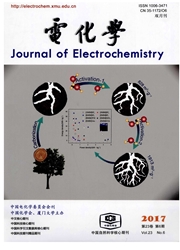

 中文摘要:
中文摘要:
电化学噪音(Electrochemical Noise,ECN)测量可用于在无电信号扰动条件下检测腐蚀体系的暂态行为,获得有关腐蚀类型和腐蚀速率的信息.小波分析不需要对ECN作稳态假设,并同时具有时间分辨和频率分辨的特点,在ECN信号处理中表现出一定的优势.本工作考察了氯离子对钢筋在模拟混凝土孔溶液中电化学噪音的影响,并采用离散小波变换(DWT)及能量分布图(EDP)分析ECN信号的时间~频率特征.结果表明,在含NaCl0.0001mol/L的饱和Ca(OH)2溶液中,时间常数为16~32s的暂态占优势;在Cl-浓度更高的溶液中,去钝化趋势为主导事件,表明钢筋在SPS溶液中活化/钝化的临界Cl-浓度介于10-4~10-3mol/L.
 英文摘要:
英文摘要:
Electrochemical noise ( ECN) measurement can provide information about both corrosion rate and corrosion type while inflicting no perturbation on the studied system. The ECN data of steel rebar in SPS with different amount of Cl-were collected and treated by discrete wavelet transformation to evaluate the contribution from transients in different frequency in the overall signals. Energy distribution plot( EDP) indicated in SPS with 0. 0001 mol/L NaCl,the transients with time constant between 16 ~ 32 s were found to be predominant over other processes; while in SPS with higher Cl-concentration,the trend toward active corrosion became the main process. It is concluded that the threshold Cl-concentration determining corrosion/passivation of steel rebar in SPS is between 10-4 ~ 10-3 mol/L.
 同期刊论文项目
同期刊论文项目
 同项目期刊论文
同项目期刊论文
 The influence of Ce(NO3)3.6H2O on the of inhibitive Effect of Ca(NO2)2 IN Simulated Concrete Pore So
The influence of Ce(NO3)3.6H2O on the of inhibitive Effect of Ca(NO2)2 IN Simulated Concrete Pore So Corrosion behavior of steel in simulated concrete pore solutions treated with calcium silicate hydra
Corrosion behavior of steel in simulated concrete pore solutions treated with calcium silicate hydra Study on interaction between macrocell and microcell in the early corrosion process of reinforcing s
Study on interaction between macrocell and microcell in the early corrosion process of reinforcing s A study on the initiation of pitting corrosion in carbon steel in chloride-containing media using sc
A study on the initiation of pitting corrosion in carbon steel in chloride-containing media using sc Study on the corrosion behavior of reinforcing steel in simulated concrete pore solutions using in s
Study on the corrosion behavior of reinforcing steel in simulated concrete pore solutions using in s The Electrochemical Characteristics of Pitting for Two Steels in Phosphate Buffer Solution with Chlo
The Electrochemical Characteristics of Pitting for Two Steels in Phosphate Buffer Solution with Chlo Corrosion behavior of reinforcing steel in simulated concrete pore solutions: A scanning micro-refer
Corrosion behavior of reinforcing steel in simulated concrete pore solutions: A scanning micro-refer Corrosion initiation of stainless steel in HCl solution studied using electrochemical noise and in-s
Corrosion initiation of stainless steel in HCl solution studied using electrochemical noise and in-s A Phtoelectrochemical Study of Highly Ordered TiO2 Nanotube Arrays as the Photoanodes for Cathodic P
A Phtoelectrochemical Study of Highly Ordered TiO2 Nanotube Arrays as the Photoanodes for Cathodic P The degradation of passive film on carbon steel in concrete pore solution under compressive and tens
The degradation of passive film on carbon steel in concrete pore solution under compressive and tens Effective monitoring of corrosion in reinforcing steel in concrete constructions by a multifunctiona
Effective monitoring of corrosion in reinforcing steel in concrete constructions by a multifunctiona 期刊信息
期刊信息
